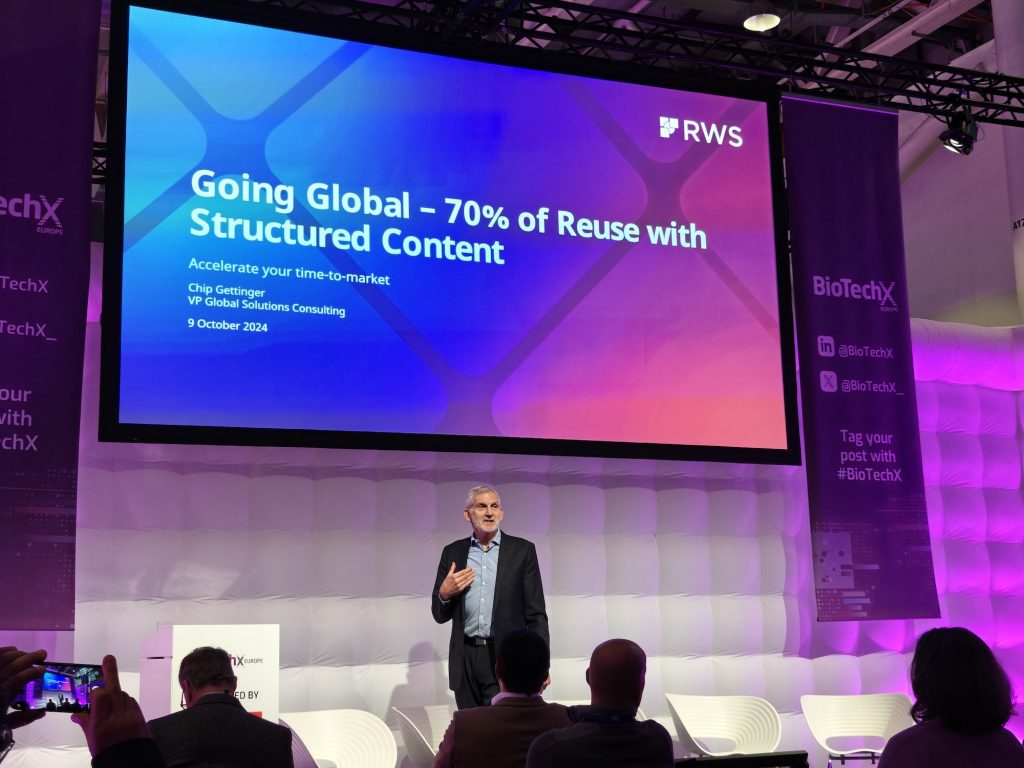The evolving landscape of global pharmaceuticals presents a significant challenge: how to accelerate the time-to-market while maintaining regulatory compliance and content consistency across regions. Adopting structured content solutions offer a transformative approach, enabling companies to manage information more effectively and facilitate faster submissions to regulatory agencies such as the EMA and FDA. At BioTechX in Basel, Chip Gettinger presented how structured content is reshaping pharmaceutical companies’ operations.
Single source of truth for regulatory compliance
At the core of structured content is the concept of a “single source of truth.” This approach ensures that document components and data are stored centrally and can be accessed, updated, and reused across multiple submissions. With a centralized component content management system, component updates in the core data are automatically reflected in all associated documents, eliminating redundancy and reducing the likelihood of errors. This consistency is especially valuable in global submissions, where varying regulatory requirements necessitate a flexible yet uniform approach to content management.

Reusable content for efficiency
Pharmaceutical companies face immense pressure to streamline content creation processes. Structured content allows for a “write once, reuse many times” approach, where semantically tagged content components such as headings, paragraphs, tables, and data elements can be reused across different documents. For instance, informed consent templates can be adapted from a global version to country-specific versions, incorporating local requirements while maintaining the integrity of the original content. This strategy reduces the time spent on authoring and minimizes errors by ensuring that the content remains consistent across documents.
Improving quality through collaboration and automation
Traditional content management practices, which are often document-centric, create silos and impede collaboration. By managing content as discrete components stored in a structured content management system, teams can collaborate more effectively on content creation and review. Automated workflows ensure that updates to content are tracked, providing a complete audit trail to support compliance.
Automation extends beyond content creation, influencing translation and localization processes. By leveraging a globally structured multilingual content approach, companies can reduce translation costs and ensure consistent messaging across different languages and markets. This integrated process also reduces administrative burdens and speeds up time-to-market.
Real-world impact on pharmaceutical operations
The benefits of structured content are already being realized within the pharmaceutical industry. For example, companies report significant reductions in the time required to update content. Tasks that previously took up to 15 hours are now completed in just five hours due to automated data integration and reusable content. Additionally, digital transformation initiatives have revealed that scientists spend approximately 800 days annually on manual tasks related to document preparation. Structured content solutions have helped reduce this workload, enabling faster product releases and more efficient use of resources.
A path forward
Adopting structured content solutions provides a clear path forward as the pharmaceutical industry continues to navigate regulatory complexities and demands for faster innovation. By unifying content management, automating processes, and enabling global consistency, structured content accelerates time-to-market and enhances quality and compliance, setting the stage for a more efficient and streamlined future in global healthcare.

Customer Success Manager at Fonto – Passionate runner and Dad
